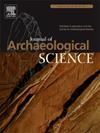写在“她”的骨头上:罗马贝鲁特的火葬和身份
IF 2.6
1区 地球科学
Q1 ANTHROPOLOGY
引用次数: 0
摘要
在公元前1世纪被吞并的时候,火葬在叙利亚的罗马行省并不是一种习俗。这与罗马帝国的西部省份形成了鲜明对比,在那里,直到公元2世纪初,火葬仍然是一种选择。因此,在罗马近东火葬的发现引发了关于被埋葬个体的身份和起源的问题。这篇文章的重点是一个来自Berytus的例子,这是罗马在近东的第一个殖民地(现代黎巴嫩的贝鲁特)。它通过骨学,化学和材料分析实现多学科方法,探索太平间实践和身份的各个方面。骨学和同位素结果表明,被埋葬的个体可能是一个非本地起源的女性。另一方面,FTIR-ATR分析以及对骨头的宏观检查表明,这是一具在高温下燃烧的新鲜尸体。此外,特殊的环境条件导致了骨灰盒内和人类遗骸上方解石晶体的形成,这些方解石晶体是用拉曼光谱识别的。同样,独特的埋葬条件导致了纺织品伪形的保存,这为人体处理方法提供了罕见的见解,这在黎凡特海岸的考古记录中通常是缺失的。通过将不同的生物考古和材料发现结合起来,本研究重建了被埋葬个体的生活史,并在罗马殖民贝鲁特的背景下考察了这种埋葬的社会和文化意义。本文章由计算机程序翻译,如有差异,请以英文原文为准。
Written in ‘her’ bones: Cremation and identity in Roman Beirut
At the time of its annexation in the 1st c. BC, cremation was not a customary practice in the Roman province of Syria. This contrasts with the western provinces of the Empire, where burning the body for burial remained the method of choice until the turn of the 2nd c. AD. As such, the discovery of cremation burials in the Roman Near East raises questions about the identities and origins of the buried individuals. This article focuses on one such example from Berytus, the first Roman colony in the Near East (modern Beirut, Lebanon). It implements a multidisciplinary approach through osteological, chemical, and material analyses to explore various aspects of mortuary practice and identity. Osteological and isotopic results indicate that the buried individual was likely a female of non-local origin. On the other hand, FTIR-ATR analysis, along with the macroscopic examination of the bones, suggest the burning of a fresh body at elevated temperatures. Furthermore, exceptional environmental conditions led to the formation of calcite crystals within the urn and on the human remains, which were identified using Raman spectroscopy. Similarly, unique burial conditions resulted in the preservation of textile pseudomorphs, which offer rare insights into body treatment practices that are typically absent from the archaeological record of the Levantine coast. By contextualizing the different bioarchaeological and material findings, this study reconstructs the life-history of the interred individual and examines the social and cultural significance of this burial within the context of the Roman colonization of Beirut.
求助全文
通过发布文献求助,成功后即可免费获取论文全文。
去求助
来源期刊

Journal of Archaeological Science
地学-地球科学综合
CiteScore
6.10
自引率
7.10%
发文量
112
审稿时长
49 days
期刊介绍:
The Journal of Archaeological Science is aimed at archaeologists and scientists with particular interests in advancing the development and application of scientific techniques and methodologies to all areas of archaeology. This established monthly journal publishes focus articles, original research papers and major review articles, of wide archaeological significance. The journal provides an international forum for archaeologists and scientists from widely different scientific backgrounds who share a common interest in developing and applying scientific methods to inform major debates through improving the quality and reliability of scientific information derived from archaeological research.
 求助内容:
求助内容: 应助结果提醒方式:
应助结果提醒方式:


